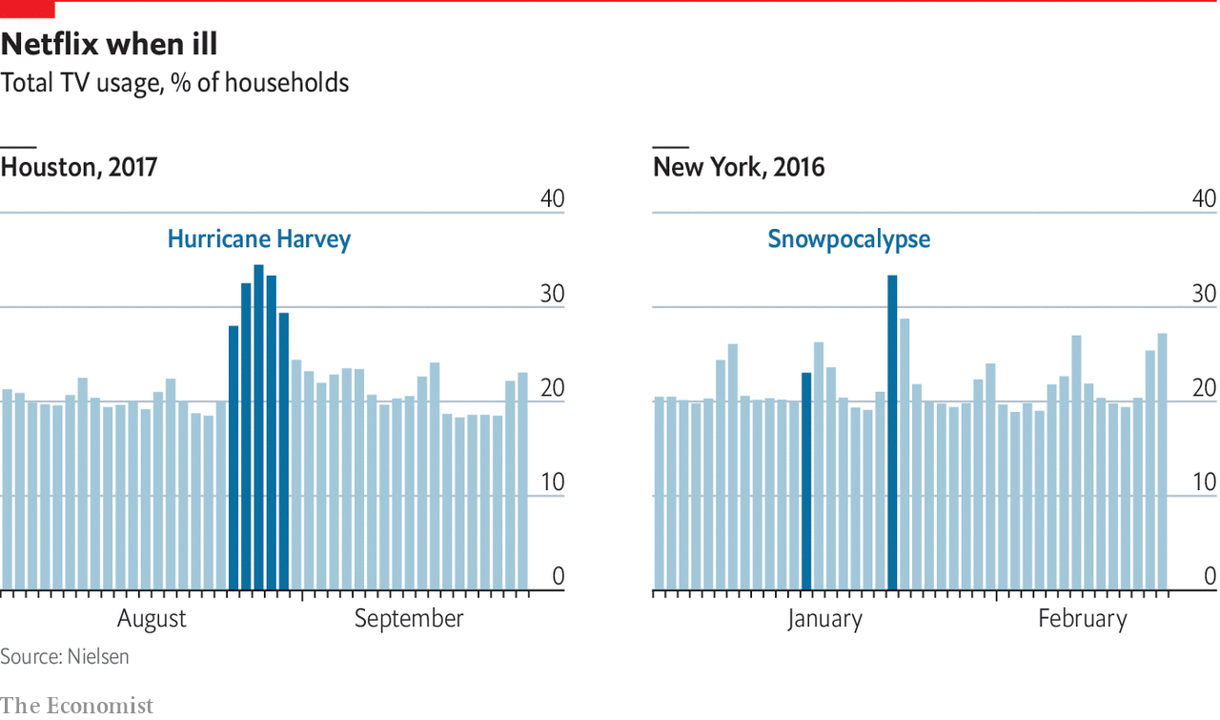FOR MOST industries, the lockdowns and social-distancing measures imposed by governments around the world to contain the covid-19 pandemic will be crippling. For video-streaming services, however, they could be a godsend. Citizens face what could be months of isolation at home, ideal conditions for binge-watching (and an ideal time for Disney to launch its streaming service, Disney+, in Europe). It is not an activity that requires much Blitz-spirit stoicism. “Your grandparents were called to war,” one Twitter user recently quipped. “You are being called to sit on the couch and watch Netflix. You can do this. #QuarantineLife”.
Data from Nielsen, a market-research firm, indicate that people do indeed turn to the box in a crisis. Television use of all sorts in America went up by 18% in the week ending March 22nd, compared with the week before. Viewership of live television rose by 14%, while the use of video-game consoles climbed by 35%. The increase in watching live TV was especially marked for teenagers (31%); many of them can no longer go to school. Overall internet usage rose by 28%, partly because so many workers must now meet their colleagues digitally, rather than face to face.

This echoes earlier research from Nielsen which analysed television usage in Houston, Texas during Hurricane Harvey in 2017, and in New York during a severe blizzard in 2016—incidents which kept people stuck indoors. In Texas, total TV use was 56% higher, over a five-day period, than a week before; in New York, it was 45% higher on the day of the snowstorm than a week earlier (see chart). Housebound residents wanted news to be kept abreast of developments, but they also wanted entertainment and feature films to stave off boredom. Nielsen found that during these events the amount of content consumed via streaming services increased by 61%.
To cope with the closure of cinemas during the coronavirus crisis, film distributors are moving their new or recent titles onto streaming services ahead of schedule. NBCUniversal is making “Emma”, “The Hunt” and “Invisible Man” available to rent on video-on-demand services; Disney+ has bumped up the online release of “Frozen 2”. Other studios have also decided to release films online.
All this bingeing may prove a distraction for some. The European Commission has expressed concern that a high volume of users streaming video in high definition could put a strain on internet bandwidth, stymying those working from home. On March 19th Netflix, Amazon and YouTube announced that they would limit the bit rate of videos in Europe and Britain—meaning that pictures would often be rendered in standard rather than high definition.
Although households will be parked on their sofas and looking for entertainment during the pandemic, it is unclear whether this sudden surge in demand will help the likes of Netflix in the long term. The company’s share price is performing well, compared with the S&P 500 as a whole, and users are probably going to be cooped up for some time. But all film productions have been shut down, so streaming services may suffer from a dearth of content in a year or two. Loyal customers, no matter how bored they are, will not put up with re-runs of old shows for ever.













